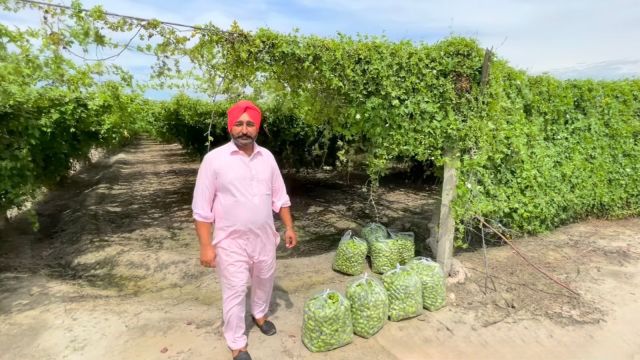Singapore streets to Punjab fields: Man turns ‘wild’ vegetable into lucrative biz
Saraan, who studied till Class XII, migrated to Singapore in 2016 and returned in 2020.
 Gurpreet Singh took a leap of faith and started cultivating a crop that most villagers barely notice — the humble kundru, also known as chibarh (Ivy Gourd), often considered a wild vegetable. ( Express Photo )
Gurpreet Singh took a leap of faith and started cultivating a crop that most villagers barely notice — the humble kundru, also known as chibarh (Ivy Gourd), often considered a wild vegetable. ( Express Photo )When Gurpreet Singh Saraan (45) returned to Sadhana village in Bathinda in 2020 after spending around five years in Singapore, he had no plans of following the conventional farming route.
Instead, he took a leap of faith and started cultivating a crop that most villagers barely notice — the humble kundru, also known as chibarh (Ivy Gourd), often considered a wild vegetable.
He now earns profit 4-5 times more than wheat and paddy per acre.
Typically found growing freely in the corners of green fields and village fences, kundru is overlooked by rural communities, but is popular in urban kitchens.
Recognising this potential, Saraan decided to turn this “wild” crop into a commercially viable product.
Saraan, who studied till Class XII, migrated to Singapore in 2016 and returned in 2020.
 He dedicated 2 acres of his 10-acre land to kundru, a crop virtually grown for commercial purposes in Punjab ( Express Photo )
He dedicated 2 acres of his 10-acre land to kundru, a crop virtually grown for commercial purposes in Punjab ( Express Photo )
He says that his time abroad shaped his perspective on work and opportunity. “I saw how even the smallest idea could create value when done systematically,” he recalls. With his elder brother (now settled in Australia), Saraan chose to invest in their ancestral land.
He dedicated 2 acres of his 10-acre land to kundru, a crop virtually grown for commercial purposes in Punjab. “People used to laugh at me often initially. But when they saw the results, they also started growing it,” he says.
Kundru, known for its climbing nature and minimal input needs, thrives best in temperatures ranging from 30°C to 35°C. “Kundru is sown in April, and harvesting from fresh vines starts in July and continues till October. Harvesting from old vines starts in April and we harvest every week,” he says, adding, “One acre yields about 200 quintals, and the input cost is just Rs 20,000–Rs 25,000 in one acre except the labour and transportation costs which is around Rs 50,000 to Rs 60,000 per acre.”
It doesn’t require any pesticides or chemical fertilizers — only cow dung manure is enough.
In the wholesale market, kundru fetches anywhere between Rs 15 to Rs 30 per kg. Saraan says the crop can generate profit worth up to Rs 4 lakh per acre, depending on weather conditions and market demand. “If any vine gets damaged, we graft it, and it regrows. Every year, we also prune the vines to maintain productivity,” he says, adding that he has planted around 500 vines in an acre. Since the two brothers had gone abroad, the family had a huge debt. “Now kundru cultivation is helping us pay our debts,” he says.
When asked how the idea of cultivating this crop came to him, he replies, “My ancestors used to grow a vine or two for self-consumption. They used to say that it is good for stomach-related problems. That inspired me to expand its cultivation and the crop never failed me.”
What started as a small experiment now provides steady employment to five families, thanks to the labour-intensive harvesting and packaging processes.
But Saraan’s farm isn’t limited to just kundru. His operations are diversified. He cultivates 2 acres of ghiya (bottle gourd), sown twice a year — in summer and winter.
In summer, it’s grown as an open-field climber vine, while in winter, it’s cultivated using low-tunnel technology, allowing for year-round production.
The production of ghiya is also around 200 quintals per acre and he fetches Rs 15 to Rs 40 per kg in the wholesale market that translates into Rs 3 lakh to Rs 8 lakh per acre depending on its demand.
The input cost, including labour and transportation, is around Rs 1 lakh per acre. “On an average as the rates remain fluctuating, one can earn up to Rs 5 lakh per acre from these vegetables after meeting the expenses,” he says.
He also dedicates one acre to cucumber farming from June to October, which also earns him Rs 1.5 to Rs 2 lakh per acre. The land is later used for winter vegetables until April. The five acres are equipped with drip irrigation. “The total water used across these five acres is less than what is needed for growing paddy on one acre,” he says.
On the remaining five acres, he grows PR-126, a short-duration paddy variety, from June to October.
After the paddy harvest, he uses the five acres to cultivate potatoes on three acres and wheat on the remaining two acres from October–November onward.
During the winter months, when kundru harvesting isn’t possible, Saraan makes good use of the space between the vines (about 15 feet apart) to grow mustard, lentils (masar), and black gram for self-consumption. “These crops help us meet our kitchen needs and also cover some of the labour costs,” he says, adding that it also improves the land quality as we cultivate residue of pulses in the soil. The leaves of kundru wines also get decomposed in the land which helps in increasing organic matter in the soil.
“Farming gives me far more satisfaction than working abroad. Here, I’m my own master — I grow what I want and earn more than I did in Singapore,” he says.







